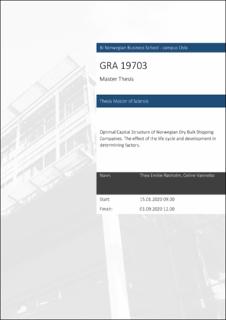Optimal Capital Structure of Norwegian Dry Bulk Shipping Companies. The effect of the life cycle and development in determining factors.
Master thesis
Permanent lenke
https://hdl.handle.net/11250/2686857Utgivelsesdato
2020Metadata
Vis full innførselSamlinger
- Master of Science [1621]
Sammendrag
This thesis focus on the optimal capital structure of Norwegian dry bulk shipping
companies and its determining factors. The research concerns whether the stage of
the life cycle of dry bulk shipping companies affects its optimal capital structure,
how optimal capital structure can be attained, as well as if the determining factors
of optimal capital structure have changed over the past 20 years. The noteworthy
characteristics of the market are subject to deeper elaboration. As follows, the
thesis accounts for subjects such as differences in the submarkets, drivers of
supply and demand, the essence of the cyclicality and profitability in the industry,
how to manage the risk, as well as the different financing options available.
To conduct the analysis, accounting data on the forty largest dry bulk companies
in Norway are gathered from Proff Forvalt. The time span on the dataset stretches
from 1998-2018 which allows us to take into account the market cyclicality when
analysing the data. Additional data are gathered from Bloomberg and Eikon. The
following analysis is conducted in Excel and Stata using financial calculations and
regression analyses. The study was based on theory on life cycle stages including
the univariate method, the comprehensive index method and the cash flow
combination method. The capital structure analysis was then based on the tradeoff
theory, the pecking order theory and empirically proven determining factors of
capital structure.
The analysis of the influence of life cycles on capital structure presented
ambiguous results. There were high fluctuations and no clear pattern. Therefore,
we rejected the first hypotheses and concluded that the life cycle does not
influence the capital structure of Norwegian dry bulk shipping companies. The
analysis of the optimal capital structure of the companies found that several
measures other than just the weighted average cost of capital have to be taken into
account. Therefore, the second hypothesis was rejected as well. At last, a set of
determining factors on capital structure is assessed to test if these have changed
over the years. Several time periods were analysed to adjust for market cycles.
The hypothesis was partly true as some of the determining factors have changed,
but there are also indications that the focus might have shifted towards other
factors over the years.
Beskrivelse
Masteroppgave(MSc) in Master of Science in Business, Accounting and business control - Handelshøyskolen BI, 2020
